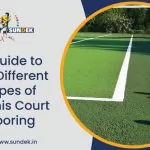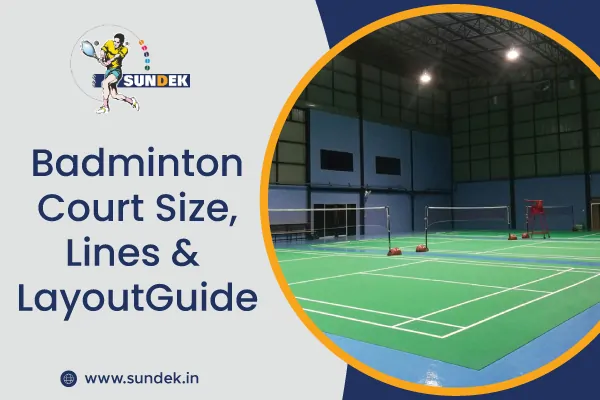Badminton is a fast-paced sport that requires agility, quick reflexes, and a clear understanding of the playing area. Whether you’re just starting out or an expert player, knowing the size, lines, and layout of a badminton court is essential for developing your game. The court size, lines, and layout all play a significant role in shaping the strategy and flow of the game. In this blog, we will break down the essential aspects of a badminton court’s size, layout, and the significance of its markings. A standard badminton court was built to provide equity and uniformity during play. A badminton court’s official dimensions for singles play are 13.4 metres long and 5.18 metres wide. For doubles play, the width expands to 6.1 meters, while the length remains the same.
Comparison with Other Court Sizes:
Tennis Court: A standard tennis court measures 23.77 meters in length and 8.23 meters in width for singles. It’s noticeably longer and wider than a badminton court.
Volleyball Court: The standard volleyball court is 18 meters in length and 9 meters in width, which is much larger than a badminton court.
The smaller size of a badminton court compared to other sports courts means players can react more quickly, making agility a key factor in the game. The compact design requires efficient footwork and positioning to cover the entire court effectively.
Badminton Court Lines
Badminton courts have various lines that define the different playing areas, including the boundary lines, service areas, and the center line. Understanding the purpose of these lines is essential for proper gameplay and strategy.
Singles and Doubles Lines:
Singles: In singles, the court is narrower (5.18 meters), and the side lines are the boundaries. The backline marks the end of the playing area for singles matches.
Doubles: In doubles play, the court width extends to 6.1 meters, with the outermost lines being used as boundaries. The backline is also used in doubles play but with a slightly different configuration.
Purpose and Significance of Each Line:
Boundary Lines: The two long boundary lines at the sides mark the limits of the court for singles and doubles.
Service Line: A service line separates the court into two halves for both singles and doubles play. The shuttle must land in the service box within these boundaries to be valid.
Center Line: The two service boxes are separated by the center line, which divides the court in half horizontally. It’s used to determine the appropriate side for serving and receiving.
Back Line: The back line indicates the farthest point the shuttle can land in the court during play.
Rules on Stepping or Crossing the Lines:
Players must be aware of their movements and avoid stepping on or crossing the lines during critical points of the game. A fault is recorded whenever a player walks outside the court or crosses the service lines while serving. The shuttle must also land within the designated service area or boundary to remain in play.
Badminton Court Layout

A badminton court layout consists of numerous lines, the net, and the service courts. The court’s layout significantly impacts strategies, positioning, and movement during a match.
Overview of the Court Layout:
Boundary Lines: These are the court’s outside borders.
Net: The net is placed at the center, dividing the two sides of the court, and it should be at a height of 1.55 meters (5 feet 1 inch).
Service Courts: The service courts on both sides of the court are divided by the center line and the service line.
Center Line: Divides the court into two halves, guiding the placement of the serve.
Strategies for Utilizing the Court Layout:
A player must use the court’s layout to their advantage. Knowing when to serve from one side or the other, utilizing the front, middle, and back court areas effectively, and staying within the lines are all part of mastering the layout. Court awareness helps players plan their shots, anticipate their opponent’s moves, and position themselves for the next play.
Common Mistakes to Avoid:
Positioning errors: Standing too close to the net or too far back from the baseline can leave a player vulnerable to attacks.
Misjudging the service area: Not positioning correctly during the serve can result in faults or ineffective serves.
Stepping out of bounds: Players should be careful not to step outside the boundary lines during play, which can result in losing a point.
Tips for Playing on a Badminton Court
Understanding the court layout, lines, and size is crucial for playing badminton at a high level. Proper footwork, positioning, and awareness of the court’s boundaries can help players perform their best.
Proper Footwork and Positioning:
Badminton requires quick, precise movements, and positioning is key to reacting to the shuttle quickly. Players should always be ready to move in all directions, making the most of their court position.
Strategies for Covering the Court Efficiently:
Excellent court coverage depends on strong footwork as well as comprehension the layout.. Always anticipate where your opponent will return the shuttle and position yourself accordingly.
Importance of Court Awareness:
Understanding the court size, lines, and layout will help players to improve their reaction time, manage their movements, and avoid unnecessary errors. Court awareness is a key element in successful badminton play.
Why Choose Sundek Sports Private Limited?
Sundek Sports Private Limited is a leading manufacturer of premium sports court flooring, including badminton court flooring in India. With year of experience, provide top-quality products designed to meet the highest performance, safety, and durability standards. Whether constructing a professional-grade badminton facility or a recreational court, Sundek Sports provides customized solutions to meet your specific needs. The company is dedicated to offering cost-effective flooring options that last, making them the trusted choice for badminton court flooring in India. Their expertise and commitment to excellence ensure that each court built with Sundek Sports flooring will perform at its best for years to come. With a wide range of options available, including easy-to-install and low-maintenance materials, Sundek Sports offers reliable solutions for any budget. Whether you’re a business, school, or individual looking to create a world-class badminton court, Sundek Sports is the go-to brand for the best flooring solutions. Contact Sundek Sports for your badminton court flooring needs today.
Conclusion
When designing or upgrading a badminton court, choosing the right court size, lines, and layout is critical for performance and safety. The dimensions, lines, and layout directly impact how players perform and move during the game. By understanding these elements, players can elevate their skills and enjoy a better experience on the court.
If you’re planning to build or renovate a badminton court, make sure to prioritize the right flooring, layout, and equipment. Contact Sundek Sports Private Limited for all your badminton court flooring needs. Call Now: +91 93203 08938 or email: info@sundek.in for more information.
FAQ
What is the size of a standard badminton court?
A standard badminton court for singles measures 13.4 meters in length and 5.18 meters in width. For doubles, the width is extended to 6.1 meters, while the length remains the same.
What are the main lines on a badminton court?
A badminton court consists of boundaries (for singles and doubles), lines of service, center lines, and the net. These lines mark the boundaries and separate the court for proper gameplay and serving.
What is the role of the center line in badminton?
The center line divides the court into two halves, separating the left and right service areas. It helps players align their serves and determines the direction of the shuttle.
Can players step on the lines during the game?
Players are not allowed to step on or over the lines during critical points, such as serving. Stepping on the lines can lead to a fault, especially during the serve.
What are the service boxes in badminton?
The service boxes are regions on both sides of the court that are delineated by the center and serving borders. The server must serve within these boxes, and the shuttle must land in the opposite box.
What is the difference between singles and doubles court lines?
Singles play on a shorter court with side lines nearer to the center line. For doubles, the court is broader, with boundaries drawn along the outside sidelines.
How does the court size affect gameplay?
The smaller size of a badminton court compared to other sports courts allows players to react more quickly, requiring efficient footwork and positioning. The compact court promotes fast-paced play and agility.
What mistakes should players avoid regarding court layout?
Common mistakes include not staying within the court’s boundaries, serving from the wrong side, or standing too far back or forward. Court awareness is key to avoiding these errors and maintaining position.
Why is understanding the court layout important?
Singles play on a shorter court with side lines nearer to the center line. For doubles, the court is broader, with boundaries drawn along the outside side lines. It improves reaction time, helps maintain balance, and minimizes mistakes, contributing to better gameplay performance.
How does the layout impact the flow of the game?
The layout influences strategy and player positioning. Efficient use of the court’s layout can lead to faster recovery, better shot placement, and improved overall performance, while a poor understanding can hinder gameplay.






